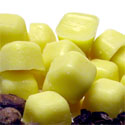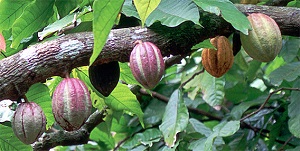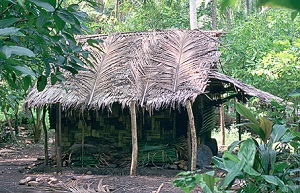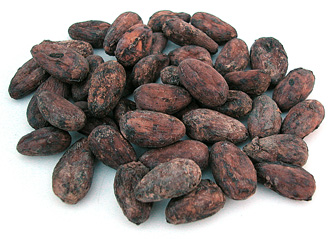Publication from the Chocolate Review
by Samantha Madell
How chocolate is manufactured
Here's a challenge:
examine the list of ingredients on any bar of fine chocolate. Cocoa
solids are listed first, right? (Hint: if sugar is listed first,
meaning that sugar is the principal ingredient, then what you've got is
a sugary confection, not a fine chocolate).
"But wait!", you
say. "The first ingredient listed on my bar of fine chocolate isn't
cocoa solids, it's cacao (or cocoa mass, or just cocoa, or cocoa
butter)". Well, OK. The point is that the one vital ingredient in all
chocolate comes from the seed of the tree called Theobroma cacao, or,
more commonly, cocoa. (The word Theobroma
means "food of the gods" in Greek, while the word cacao is derived from
the ancient Mesoamerican name for cocoa. The common name cocoa is
thought to be an Anglicised version of the word cacao). But what
exactly are cocoa solids? How are they obtained from the cocoa tree,
and how are they transformed into chocolate?

Cocoa butter is solid at room temperature
The
term "cocoa solids" refers to both nonfat cocoa solids, or NFCS (i.e.
the brown stuff that gives chocolate its characteristic taste and
colour), and cocoa butter (the relatively bland-tasting yellow
vegetable fat obtained from cocoa beans). Cocoa butter is solid at room
temperature, hence its inclusion in the category of cocoa solids.
Cocoa
trees are native to South America, and they have a very long history of
cultivation in Central America, but these days cocoa is grown in more
than 40 countries located on or near the equator. Most of the countries
that grow cocoa are very poor (Australia being one notable exception).
Indeed, the poverty of cocoa growers is an important issue, all too
often ignored or glossed over by people in the chocolate industry (here
at ChocolateReview we're working to expose - and change - some of the
more unsavoury aspects of the chocolate industry, but that's another
story).
Cocoa beans grow in pods, with 20 to 60 beans per pod.
The number of pods produced by each tree depends on several factors
such as the variety of cocoa being grown, the skill of the grower, and
the amount of chemical inputs that are used. But on average, each tree
produces about 75 pods per year. Seventy-five pods will yield
approximately 3kg of dried, saleable cocoa beans.
After the cocoa pods are cut from the tree, they are broken
open, and the beans are scooped out. At this stage, the beans are
encased in a sweet, tangy, white pulp, which tastes somewhat like
mango. The beans themselves range in colour from white (as is the case
with Criollo), to bright purple (as is the case with Forastero). Fresh
out of the pod, the beans are extremely unpalatable: they taste bitter
and astringent, have a somewhat cheesy texture, and bear no resemblance
to chocolate at all.
The fresh beans must be fermented for up to
a week in order to develop so-called "aroma precursors", via a series
of chemical reactions. To ferment properly, the beans must be placed in
a large enough pile to prevent them from drying out. Sometimes, a
fermentation heap is made on the leaf-strewn floor of the plantation,
while in larger plantations and co-ops it is common for special wooden
fermentation boxes to be used for fermenting the cocoa.
If you'd like to know more about fermentation, please have a look at a page I put together for the Tava website called "Theobroma cacao: from Bud to Bean".
Once
the beans have been adequately fermented, they must be dried in order
to halt the fermentation process, and remove excess moisture. Proper
drying helps prevent the beans from rotting or going mouldy.
Methods
of drying cocoa beans vary substantially between countries and
plantations. In some places, rainfall is low enough to allow the beans
to be sun dried. Usually this means that a single layer of beans is
placed on a sheet of plastic, or on a concrete slab, or even (though
not desirably) on an asphalt roadway!

Cocoa pods at various stages of ripeness
A basic structure used for force-drying cocoa in Vanuatu. Most of the building materials come from the surrounding jungle.
However,
because cocoa trees thrive in the wet tropics, many cocoa growing
regions are too wet to enable sun drying. In these places, the beans
are force-dried. Like sun-drying, methods for force-drying vary from
place to place, but the principle remains the same: the beans are
placed on a platform beneath a cover (to keep rain off), and above a
heat source. The heat is usually generated by a fire, which is
typically fueled by wood or gas.

A basic structure used for force-drying cocoa in Vanuatu.
Most of the building materials come from the surrounding jungle.
There
is nothing inherently wrong with force-drying cocoa beans, but
unfortunately, force-drying methods are often poorly executed, leading
to a number of potentially serious defects in the finished product. One
of the most common - and serious - defects caused by force-drying is
smoke-taint in the beans. Smoke taint occurs when the beans are exposed
to smoke from the heat source, leading to an end product that smells
and tastes smoky. Occasionally, smokiness in chocolate is promoted by
manufacturers as a desirable characteristic, but the reality is that
the "smoking" of cocoa beans is an accidental and uncontrolled process
(unlike the carefully controlled smoking of products such as ham,
cheese, or whisky). Smoky cocoa beans are considered to be defective
and unmerchantable under the International Cocoa Standards [1].
When
the beans have been fermented and dried, they are packed up in jute
sacks. Typically, each sack weighs 60kg. The beans are then shipped to
manufacturers, the vast majority of whom are located in Europe and the
USA.
Most of the world's cocoa beans are processed into cocoa
liquor, cocoa butter, and cocoa powder by a handful of huge
multinational companies that sell these pre-processed ingredients to
chocolate factories. Hence, you'd be correct in reaching the logical
conclusion that most so-called "chocolate makers" don't actually work
with raw cocoa beans at all.
But a small - and growing - group
of chocolate devotees around the world do make chocolate from raw cocoa
beans. As with the fermentation and drying of cocoa beans, there are
many different methods of manufacturing chocolate, but the basic
principles remain the same:
First, the beans must be cleaned of foreign matter such as dust, jute fibres, sticks and stones.

Unroasted cocoa beans. The beans in this image are about actual size
Next,
the beans are roasted to produce the desired chocolatey flavour.
Roasting times and temperatures vary depending on the variety of bean
being used, and the type of chocolate that is to be made. During
roasting, the beans undergo a chemical process called a Maillard
reaction, which is a browning reaction. The Maillard reaction in cocoa
can produce many desirable (and undesirable) flavour characteristics in
chocolate, including caramel, nutty, earthy, malty, and coffee flavours
and aromas (as well as sour, musty, and burnt flavours and aromas).
After
roasting, the beans are cracked and winnowed. Winnowing is the process
of blowing air over the cracked beans to remove the crisp, papery
shells from the edible nibs.
The roasted, winnowed cocoa nibs
are turned into cocoa liquor by grinding. Cocoa liquor is not alcoholic
(the word "liquor" really just means "liquid").
When the desired
ingredients (namely cocoa liquor, sugar, and possibly milk powder,
vanilla, and an emulsifier) have been combined, the warm chocolate
paste is refined in order to produce a small, consistent particle size
in the product. A small particle size creates a silky mouthfeel in the
finished chocolate. Traditionally, roll refiners have been used for
this process (whereby the chocolate passes between closely-spaced
rollers). However, many factories these days use other means of
refining, such as ball mills (whereby the chocolate ingredients are
placed in a vessel which is partly filled with small metal balls. The
chocolate and the balls are agitated for a period of time, which causes
the balls to crush and break up the chocolate particles).
To
make an extra-buttery chocolate, additional cocoa butter is often
added. Chocolate made without extra cocoa butter can have a dry and
crumbly texture. To obtain cocoa butter, it must be separated from
cocoa liquor by placing the liquor under immense pressure. The
by-product of pressing cocoa butter - called presscake - is pulverised
to make cocoa powder.
The refined chocolate - with cocoa butter
added - is then conched. Conching is a process that was stumbled upon
by Rudolph Lindt in the 1870s. Conching takes its name from the machine
orginally used by Lindt, which he thought resembled a conch sea-shell.
The principle of conching is that the warm chocolate is mechanically
agitated or kneaded, continuously, for a period of time that can extend
to several days. Conching improves the flavour of the chocolate by
expelling harsh-tasting volatile acids. In a factory with modern
refining machinery, conching does not further refine the particle size
of the chocolate, but conching is believed to improve the texture of
the chocolate by smoothing the rough edges of each particle, and by
evenly coating each particle in cocoa butter.
The final process
prior to moulding is tempering. Correct tempering produces a very
glossy chocolate, which makes a nice sharp snap when broken. Correctly
tempered chocolate will also resist problems associated with
temperature fluctuations, such as fat bloom. (Fat bloom is the dull
grey film which sometimes forms on chocolate, and can be mistaken for
mould).
Most chocolate is about 40% fat. Tempering is the
process of producing the most stable form of fat crystal in the cocoa
butter. Cocoa butter can crystallize (or solidify) in several different
forms, each of which has a different melting point. The most stable
cocoa butter crystal is known as the beta (β) form.
During
tempering, the beta form of cocoa butter is produced by precisely
manipulating the temperature of the melted chocolate. First, the
chocolate is heated until all of the crystals in their different forms
have melted (45ºC is adequate). Then, the chocolate is cooled to a
temperature at which beta crystals can form, but which is still warm
enough to prevent the undesirable crystals from forming (the correct
temperature is about 29ºC).
The tempered chocolate can then be poured into moulds, cooled to set ... and then enjoyed!
References:
1 The international cocoa standards are set out by the
International Standards Organization, in the document ISO 2451
|
Copyright © 2008 Chocolate Review
|